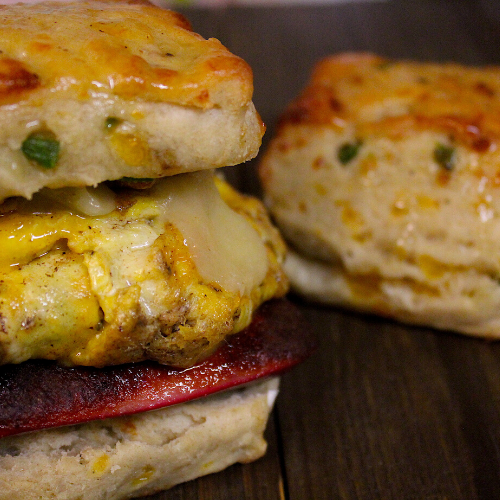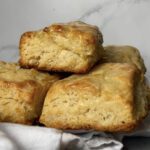We make a lot of biscuits!
Some are straightforward and classic like our buttermilk biscuits. Others, like our sweet potato & sage biscuits, are unique experiments that people just happen to love. All of them are successful because we keep these biscuit pro tips in mind.
1) Use very cold/frozen butter (or whatever fat you use)
The best part about biscuits is the fluffy, buttery-ness of it all. And those visible specks of butter in your biscuit dough are what makes that happen. To keep your butter from melting completely during the mixing and kneading processes, start with very cold butter.
Frozen butter is recommended, but admittedly, it can be a hassle to grate or cut frozen butter into small pieces. So use a grater or food processor to shred the butter and make mixing it into your dough quickly as simple as possible.
Working in a cool room and keeping your hands/tools cool while working with the dough also help to keep the butter from melting too quickly.
2) Don’t over mix/over knead the dough
Another way to keep the butter from melting too quickly is to avoid over mixing the dough. When you knead the dough, gluten bonds are being created. To a point, that’s a good thing. It’s what we want! But past a certain point, it will make your biscuit tough instead of melt-in-your-mouth tender.
Mix in the bowl until a loose dough comes together. It may still be a little wet and scraggly, and that’s fine. Add flour to a clean surface, empty the dough onto the flour, then add more flour on top of the dough. At this point, you should gently (but quickly) bring the dough together into a rectangle. For additional layers, you can fold the rectangle into a tri-fold like a brochure (and repeat this up to 3x). This is optional though.
If the biscuits are still a little sticky, again, this is fine, but they should hold their shape and be relatively easy to remove from the biscuit cutter.
3) Make the most out of your first roll-out
Because of the additional flour that’s needed between each roll out, biscuits in the same batch can have drastically different textures. Try your best to knead and roll out as much of the biscuit dough as possible the first go-round.
Once you’re left with the scraps, gather them and re-roll them. Try to add as little extra flour as needed, just enough to keep the biscuits from sticking to the surface.
And some bonus tips & tricks we use in the Mobile Soul Kitchen…
4) Baste with a little butter mid-bake
There’s no fancy science behind this thing that we do with our biscuit, but it definitely helps add more buttery flavor to the biscuits to baste them while they bake.
5) Buttermilk works wonders
The acidity in buttermilk helps to make things tender. This is the case when it is used in chicken brines, for cakes, and for biscuits as well. It also helps activates the baking soda in some biscuit recipes to give them some impressive height.
6) Don’t twist biscuit cutter
Whether you choose to go with a round, square, or another biscuit shape, don’t twist and shake the biscuit cutter while removing it from the dough. This will likely ruin all those beautiful layers you want to see when the biscuits are finished baking.
7) Invest in a really good butter
You can make biscuits with pretty much any butter, but you can definitely taste the difference when you use the more expensive stuff. If you’re going for really tasty biscuits, it’s always worth it to splurge a bit on the butter. Usually, the higher the fat content, the better.
Cultured butter tends to lose their unique tastes during baking so they are best enjoyed on a piece of toast or slathered on your finished biscuits!
Our favorite butter brands to use for biscuits
Vital Farms’ Pasture-Raised Butter
Nellie’s Free Range Slow Churned Butter


